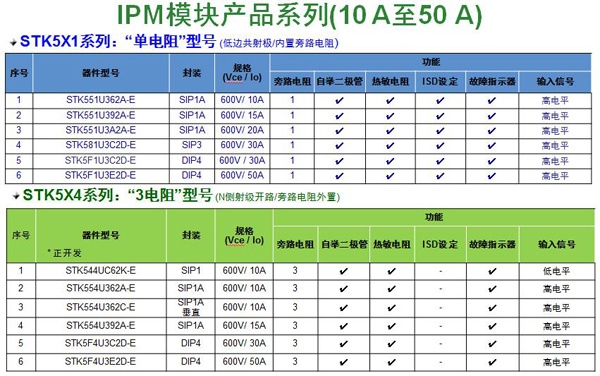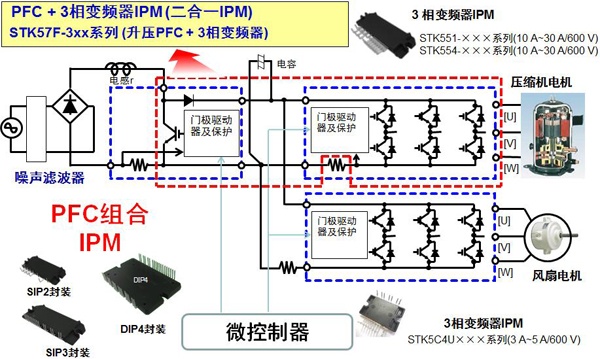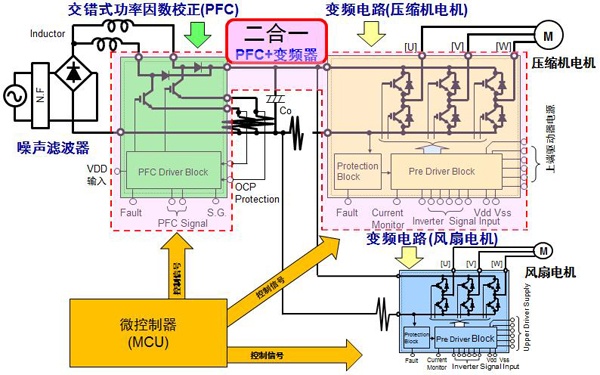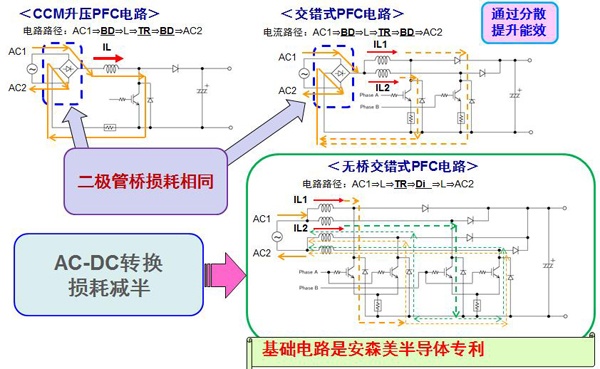At present, the technology of consumer electronic products is changing with each passing day. At the same time, the ideas of green, environmental protection and energy conservation are gradually becoming popular. The issue of energy efficiency has increasingly become the focus of product design. High efficiency and energy conservation are the trend of the times. As a key component of electronic design, semiconductor products play a vital role. Engineers provide solutions for various application needs through different designs of materials, structures and processes of semiconductor devices.
White goods, such as air conditioners, refrigerators, washing machines, etc., which are closely related to our daily life, need to consider factors such as size, energy efficiency, cost and design in design. ON Semiconductor, which drives energy-efficient innovation, has developed a compact inverter intelligent power module (IPM), as well as a "two-in-one" IPM with integrated power factor correction (PFC) converter and three-phase inverter, using a unique insulated metal substrate Technology (IMST®), reliable, cost-effective, while providing energy efficiency and low noise, is ideal for white goods applications. The two-in-one IPM STK57FU391A-E won two awards from China Electronics and 21ic.com for the 12th Annual TOP-10 Power Product Awards in China: “Top 10 Power Product Award†and “Technology Breakthrough Awardâ€. Highlights the strength of ON Semiconductor to drive energy-efficient innovation.
ON Semiconductor's unique Insulated Metal Substrate Technology (IMST)
ON Semiconductor is the first company in the world to develop a frequency converter IPM using IMST technology. IMST technology uses a low thermal resistance, high thermal conductivity insulating material to press together the copper foil and the metal substrate, that is, the aluminum substrate. The high thermal conductivity of the metal enables the power output circuit, the control circuit, and the peripheral circuit of the module to be mounted on the same substrate. This technology has seven technical advantages, including: easy integration and reduced component count to reduce total cost, built-in peripheral circuitry to simplify PCB design to shorten end product design time, provide more sensitive and accurate temperature sensing for more reliable heat dissipation Protection, noise suppression, reduced surge voltage, improved energy efficiency and reduced power consumption, as well as single in-line (SIP) type packaging advantages.
IMT-based IPM module
ON Semiconductor's IPM module based on IMST technology, including single shunt resistor and 3-shunt resistor (as shown in Table 1), it will be high voltage IC (HVIC), high breakdown voltage and high current IGBT, fast recovery diode, Gate resistors, start-up diodes for driving the upper IGBT and IGBT gate resistance, thermistors for detecting heat, and shunt resistors for overcurrent protection are packaged together in high-density mounting (see Figure 1). Show), can drive load current from 10 A to 50 A, providing low loss and low noise.

Table 1: Lineup of ON Semiconductor IPM modules. 
Figure 1: The IPM module based on IMST technology integrates multiple components.
Integrated PFC and 3-phase inverter 2-in-1 IPM for inverter air conditioner
In response to the trend of reducing size and improving energy efficiency, ON Semiconductor IPM has developed into the next generation of energy-efficient 2-in-1 IPM. Its STK57F-3xx series IPM will boost PFC converter and 3-phase inverter (STK551-xxx series, STK554) The -xxx series provides drive for the compression motor, and the STK5C4Uxxx series provides the drive for the fan motor. (See Figure 2), which not only provides energy-efficient circuits, but also significantly reduces the number of components, saves PCB space, shortens development time, and reduces Assembly costs and speeding up the listing process.

Figure 2. ON Semiconductor's 2-in-1 IPM for inverter air conditioners.
ON Semiconductor develops an interleaved PFC 2-in-1 IPM for higher current, higher power applications. See Figure 3, which integrates an interleaved PFC converter, a three-phase inverter output section, a pre-driver circuit, and a protection circuit in a single package. The interleaved PFC is replaced by placing two smaller power PFC segments in parallel at the original single higher power PFC segment. The two smaller PFC sections alternate with a phase shift of 180°, and when they are accumulated at the input or output, the main portion of the current ripple per phase will cancel.

Figure 3. Interleaved PFC 2-in-1 IPM.
Energy-efficient single-phase PFC applications include: continuous conduction mode (CCM) boost PFC, interleaved PFC, and bridgeless interleaved PFC. CCM boost PFC circuit as our basic circuit, the interleaved PFC is actually two boost circuits in parallel, MOS tube staggered conduction. Although the same diode bridge loss is generated with the CCM boost PFC, the interleaved PFC can disperse the power supply to improve energy efficiency, while the bridgeless interleaved PFC removes the diode rectifier bridge based on the interleaved PFC structure, reducing the reactor size by 40. %, AC-DC conversion loss is reduced by 50%, see Figure 4.

Figure 4. Energy efficient single-phase PFC application approach.
2-in-1 IPM vs. other programs
Taking the inverter air conditioner as an example, when the discrete structure is adopted, the total number of circuit components is up to 15, and the PCB area is up to 121.2 cm2, while the 2-in-1 IPM structure is more integrated, and the total number of components is reduced to six. The PCB area is reduced to 87.5 cm2.
Under the same working conditions (taking input voltage 220 V, power 4 kW as an example, see Figure 5), the 2-in-1 IPM structure provides a higher operating frequency than the discrete structure. The total loss of the interleaved PFC system is 28.1 W less than the discrete structure. The bridgeless interleaved PFC reduces total system losses by 38%. In terms of cost, the smaller size is easier to design, making it easier to adopt a modular solution, shortening the design cycle and reducing development costs. The more integrated 2-in-1 IPM structure allows the booster coil to be placed on the board, reducing assembly costs, and due to different topologies, common boost PFC 2-in-1 IPM, interleaved PFC 2-in-1 IPM and The core size of the bridgeless interleaved PFC 2-in-1 IPM was reduced to 79%, 33%, and 20% of the discrete structure, and the total system cost was reduced from $29.7 for the discrete structure to $28.7, $28.6, and $28.3.

Figure 5. PFC total loss and cost comparison for PFC systems.
to sum up
ON Semiconductor's innovative IMST technology is reliable and cost-effective, while providing energy efficiency and low noise, and the 2-in-1 IPM STK57FU/5MFU based on this technology is significantly reduced due to the integration of PFC converters and frequency converters in a single package. The number of components reduces the space occupied by PCBs, reduces assembly costs, reduces energy consumption and improves energy efficiency. Key features include built-in overcurrent protection and overvoltage protection, built-in thermistor to monitor temperature, start-up circuitry with built-in IPM for single-supply drive, and built-in circuitry to prevent simultaneous conduction of the upper/lower transistors. The ideal solution for home appliance applications.
Introduction
SCOTECH manufactures a full range of pad mounted distribution transformers, it consists of HV compartment, LV compartment and Transformer compartment, they are compact power system for utility, commercial and industrial applications. the Pad Mounted Transformer can be installed indoor or outdoor and designed to withstand most of the environments. it can also be designed specifically for the solar photovoltaic generator applications.
Scope of supply
Primary voltage up to 35KV
Rated power: up to 5MVA
Standards
SCOTECH`s pad mounted distribution transformers are designed and manufactured in accordance with all major international standards (IEC, ANSI, UL, etc.)
Why SCOTECH
Long history- Focus on transformer manufacturing since 1934.
Technical support – 134 engineers stand by for you 24/7.
Manufacturing-advanced production and testing equipment, strict QA system.
Perfect service-The complete customer service package (from quotation to energization).
Pad Mounted Transformer
Pad Transformer,Pad Mounted Transformer,3 Phase Pad Mounted Transformer,Pad Mounted Distribution Transformer
Jiangshan Scotech Electrical Co.,Ltd , https://www.scotech.com